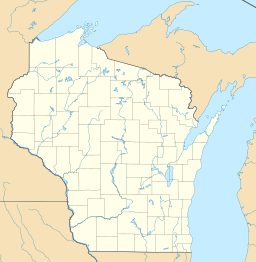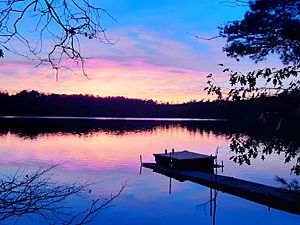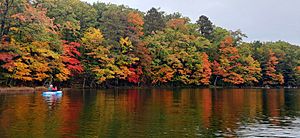Alma Lake (Wisconsin) facts for kids
Quick facts for kids Alma Lake |
|
|---|---|
| Location | Vilas County, WI |
| Coordinates | 45°54′35″N 89°25′42″W / 45.90972°N 89.42833°W |
| Basin countries | United States |
| Max. length | 824 m (2,703 ft) |
| Max. width | 434 m (1,424 ft) |
| Surface area | 233,500 m2 (58 acres) |
| Average depth | 3.4 m (11 ft) |
| Max. depth | 5.5 m (18 ft) |
| Water volume | 750,000 m3 (0 km3) |
| Residence time | Approx: 3 years |
| Surface elevation | 491 m (0 km) |
| Settlements | St. Germain |
Alma Lake is a small lake in North-Central Wisconsin. It's located in Vilas County, near the town of St. Germain. The lake covers about 57.7 acres (233,500 square meters). Its deepest point is 5.5 meters (18 feet) down. On average, it's 3.4 meters (11 feet) deep. The bottom of the lake is mostly sand (50%) and gravel (40%). The rest is mulch (10%). You can find a public boat landing on Red Oak Road. The lake always has a slow, no-wake speed limit for boats.
History of Alma Lake
In 1902, the Red Oak Resort was built on Alma Lake by George Jackson. Later, in the 1920s, Walter and Wilka deHaas bought the resort. By the 1960s, Alma Lake was home to three different resorts. These were The Twilight Resort, Lindquist’s Log Cabins, and deHaas Red Oaks.
Each resort had its own sandy beach for guests. The Red Oaks Resort also rented out small boats. Between 1965 and 1974, all three family-owned resorts on Alma Lake were divided into smaller properties. The people who owned property around the lake formed the Alma-Moon Lake Association in 1969-1970. By 1971, they agreed to set a 5-mph speed limit for boats on Alma Lake.
How Alma Lake Works
Alma Lake is a type of lake called a seepage lake. This means it doesn't have streams flowing into or out of it. However, Alma Lake is connected to Moon Lake by a channel.
The lake's water changes throughout the year. In summer, the water forms layers, with warmer water on top and colder water below. In the fall, the lake "turns over" and all the water mixes together. This happens again in the spring. Because of this, it's called a dimictic lake.
In winter, Alma Lake usually freezes by the end of November. It stays frozen until late April or early May. The water temperature just below the ice drops to 0°C (32°F). The warmest temperature ever recorded in the lake was 27.6°C (81.7°F) in July 2006.
Alma Lake has clear, blue water. You can usually see down about 3.6 meters (11.9 feet) using a Secchi disk. This tool helps measure how clear the water is. Clearer water often means less chlorophyll-a, which is a green pigment found in algae. Alma Lake has low levels of phosphorus, which limits how much algae can grow.
Animals and Plants
Alma Lake is home to 34 different kinds of native water plants. One of these is the northeastern bladderwort. This plant is special and is watched by the Wisconsin Natural Heritage Inventory Program. The most common plant in Alma Lake is dwarf watermilfoil.
The only invasive species found in Alma Lake is the Chinese mystery snail. Luckily, zebra mussels have not invaded Alma Lake. This is because the lake's water has a pH of 6.8 and very little calcium, which zebra mussels need to survive.
Many types of fish live in Alma Lake. These include muskellunge, panfish, largemouth bass, smallmouth bass, walleye, crappie, rock bass, sunfish, bluegill, perch, and northern pike. The lake has a medium level of plant and algae growth, which means it is a mesotrophic lake.
How People Use the Lake
Most of the land around Alma Lake is covered by forests. Homes and other buildings make up only a small part (about 2%) of the land around the lake. Wetlands, which are areas where the land is covered by water, make up only 1% of the area.





